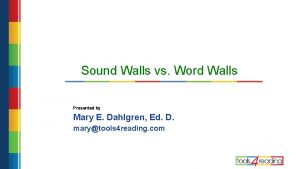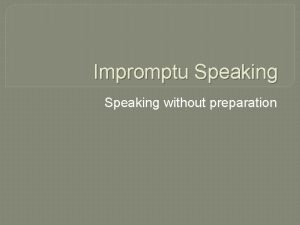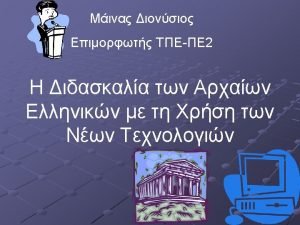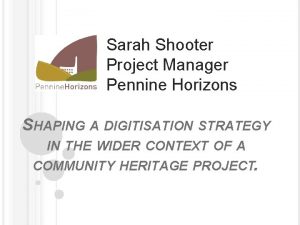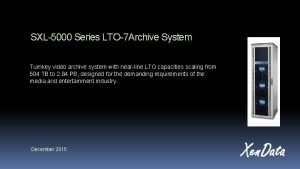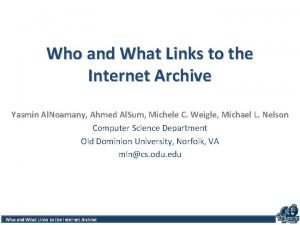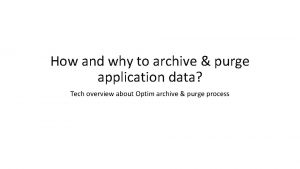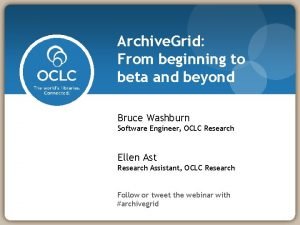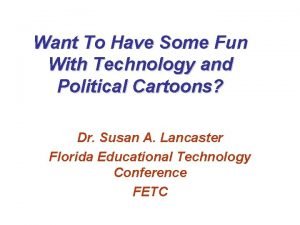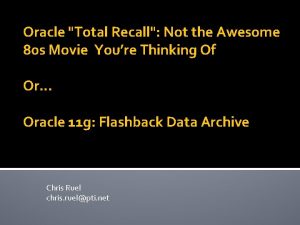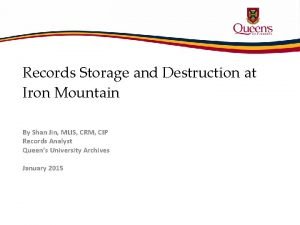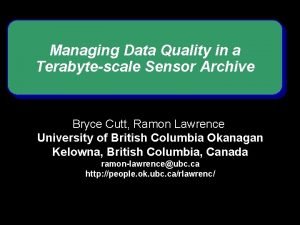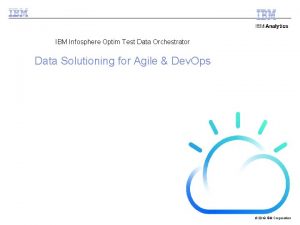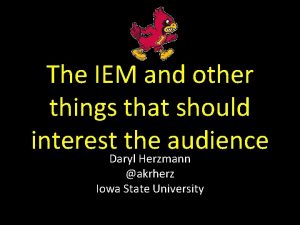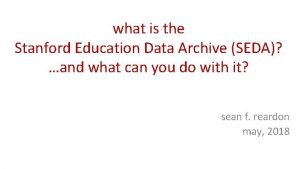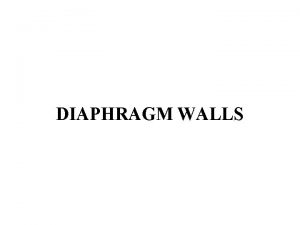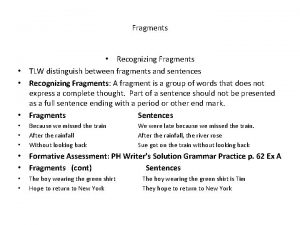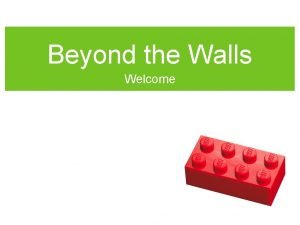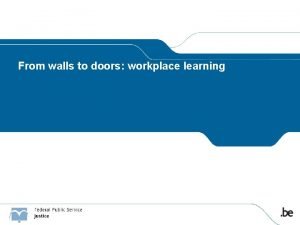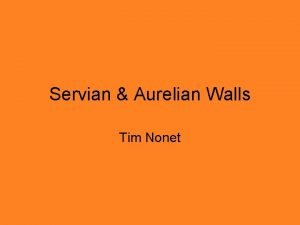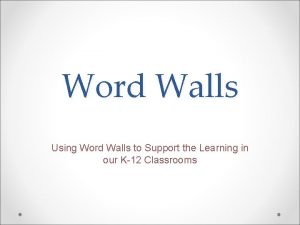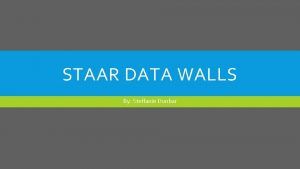Korculas Fragments Walls Speak https archive orgdetailsKorculas Fragments

















- Slides: 17

Korcula's Fragments Walls Speak https: //archive. org/details/Korculas Fragments. Walls. Speak. Outsound. P oetry

Problematising the concept of ‘voice’ in Early Childhood research Rob Abbott, Nikki Fairchild, Sandra Lyndon and Eva Mikuska University of Chichester

Overall aim • To explore different ways of conceptualising voice and its impact on practice, drawing upon a range of qualitative research methodologies within the Early Childhood Education and Care (ECEC) field of inquiry. • To complete a small scale research project to understand how others conceptualise voice (consent forms; information sheets to follow; and audio/video recording).

Our research questions: • How can voice be explored which allows for multidimensional presentations? • How can the experience of others be presented without being dominated by the interpretation of the researcher? • How could arts based methods be used to explore understandings of voice?

Why arts based methods? • Building on the work of Byrne (2015) and her study about using poetry to present the different voices of students and their experience of education. • Byrnes (2015) argues that arts based methods enables: • Data to presented in different ways; • Enables different voices to be presented: participant; researcher; and respondent; • Helps to address issues of power between the researcher and participant.

The student voice - Rob Research focussed around a year one Child Development module: Problem-based learning Formal lectures Podcasts On-going and mid-term feedback from students largely positive. “The PBL sessions for me were not useful as we constantly felt unaware of what needed to be done. ” “I felt like we needed more guidance throughout the PBL tasks, not always very clear. ” “The PBL groups took up too much time, there was no[t] enough time spent on theory or application of it. ”

Issues around the student voice Rob • How should I react to the feedback I was given; how do I hear the voice that was spoken? • How do I ensure that my students have the language to speak, the knowledge to understand what they speak, and the power to feel they can say it? • How can we create an environment that allows for meaningful dialogue where both voices can be heard?

Narrative Imagination and Voice – Sandra • Andrews (2014, p. 1) states that ‘narrative and imagination are integrally tied to one another’. • They bring into focus: • The ability to time travel, i. e. ‘moving backwards and forwards in our mind’s eye’ (p. 3) • A link between the ‘real, the not-real, the not yet real’ (p. 2) • A construction of the self and other • How does narrative imagination link to the construction of voice?

Damp Clothes ‘One of my children came in and I needed to change their clothes and their bag had loads of nice clothes in but they were damp. . obviously I thought you know that could have just been they were rushed in the morning […. ] and then it happened again and then there were just small things that would come so like … the shoes suddenly … a little bit too small…[…] it would be like ‘I think they’re saying their feet are hurting so they might need some …’ yer and it’s that look you know you just see that face that ‘oh god […] I can’t get them any more shoes. ’ Key Worker for children under the age of 3

What is ‘voice’? Eva • Problematising the meaning of voice that are historically grounded in positivism, interpretivism and critical theory ( Mazzei and Jackson, 2009). • The process of turning voice into text which is then deconstructed, that is exposing the instability of meaning which the text tries to cover up. • Can we become a source of voice rather than an effect of it, when ‘it’ can be culture, structuring principles etc. ? • Can we occupy the position of ‘other’? • Voice is not monolithic – dominant meanings can be contested and alternative meanings affirmed (Weedon, 2009). (we=researchers)

Example - Eva Really

A more than human voice - Nikki

Activity Think about a childhood memory and think about how to present this memory using the range of materials on offer (or not!) You may wish to make, draw, build, record this. This could be on your own or in groups – the choice is yours. You have 15 minutes

Reflection Why did you choose that particular medi(a)(um) to present your voice? Please would you share one aspect about this session or the activity (presentation of the voice) with the wider group

Closing thoughts How might you use what we have discussed today in your wider professional life (research or practice). . .

References • • • Andrews, M. (2014) Narrative Imagination and Everyday Life. Oxford: Oxford University Press Byrne, G. (2015) Narrative Enquiry and the Problem of Representation: ‘giving voice’, making meaning. International Journal of Research and Method in Education. 1 -17 Bennett, L. (2016) ‘Thinking Like a Brick’ in C. A. Taylor and C. Hughes (eds. ) Posthuman Research Practices in Education. London: Palgrave Macmillan. Jackson, A. Y. and Mazzei, L. (2012) Thinking with Theory in qualitative Research. Viewing data across multiple perspectives. Abingdon: Routledge. Lather, P. and St. Pierre, E. A. (2013) ‘Post-qualitative research’. International Journal of Qualitative Studies in Education. 26 (6): 629 – 633. Mazzei, L. (2013) ‘A voice without organs: interviewing in posthumanist research’ International Journal of qualitative Studies in Education. 26(6), 732 -740. Mazzei, L. (2016) ‘Voice without a Subject’ Cultural Studies<>Critical Methodologies. 16(2), 151 -161. Taylor, C. A. and Hughes, C. (eds. ) (2016) Posthuman Research Practices in Education. London: Palgrave Macmillan. Weedon, C. (1997) Feminist Practice and Poststructuralist Theory. 2 nd Edition. Oxford: Blackwell

Contact Details Rob Abbott – r. abbot@chi. ac. uk, Nikki Fairchild – n. fairchild@chi. ac. uk, Sandra Lyndon – s. lyndon@chi. ac. uk, Eva Mikuska – e. mikuska@chi. ac. uk Senior Lecturers Department of Childhood, Social Work and Social Care University of Chichester, College Lane, Chichester, West Sussex, PO 19 6 PE. 17
 I build walls poem
I build walls poem Sound wall instead of word wall
Sound wall instead of word wall How to speak without preparation
How to speak without preparation Joanne archer umd
Joanne archer umd Classics mit edu
Classics mit edu Pennine horizons digital archive
Pennine horizons digital archive Video archive system
Video archive system Internet archive xx
Internet archive xx Optim archive tool
Optim archive tool Washburb
Washburb Pat oliphant cartoon archive
Pat oliphant cartoon archive Oracle total recall
Oracle total recall Iron mountain archive boxes
Iron mountain archive boxes Nexrad archive
Nexrad archive Qué es ibm infosphere optim
Qué es ibm infosphere optim Iem cow text archive
Iem cow text archive National archive of criminal justice data
National archive of criminal justice data Stanford education data archive
Stanford education data archive

